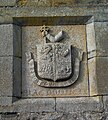
Baron Inchiquin is one of the older titles in the Peerage of Ireland. It was one of two titles created on 1 July 1543 for Murrough O'Brien, Prince of Thomond, who claimed descent from Brian Boru, a High King of Ireland. The grant of the English titles was conditional upon the abandonment of any Irish titles, the adoption of English customs and laws, pledging of allegiance to the Crown, apostasy from the Catholic Church, and conversion to the Church of Ireland. Murrough was made both Earl of Thomond in the Peerage of Ireland, with remainder to his nephew Donough O'Brien and Baron Inchiquin, with remainder to his male heirs. Following the death of his cousin, Conor Myles John O' Brien in June 2023, Conor John Anthony O' Brien is currently the 19th Baron Inchiquin

Bunratty Castle is a large 15th-century tower house in County Clare, Ireland. It is located in the centre of Bunratty village, by the N18 road between Limerick and Ennis, near Shannon Town and its airport. The castle and the adjoining folk park are run by Shannon Heritage as tourist attractions.

Killone Abbey, situated in Killone, some 5 kilometres south of Ennis, County Clare, was a nunnery and abbey of Canonesses Regular founded in 1190 by Donal Mor O'Brien, King of Thomond and Munster and dedicated to Saint John. It lies on the banks of Killone Lake.

Corofin is a town on the River Fergus in northern County Clare, Ireland and also a parish of the same name in the Catholic Diocese of Killaloe.
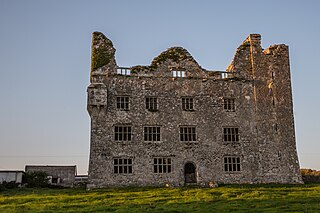
Leamaneh Castle is a ruined castle located in the townland of Leamaneh North, parish of Kilnaboy, between the villages of Corofin and Kilfenora at the border of the region known as the Burren in County Clare, Ireland. It consists of a 15th-century tower house and a 17th-century mansion.

Murrough O'Brien, 1st Earl of Thomond was the last King of Thomond, and a descendant of the High King of Ireland, Brian Boru.

Clare Abbey, also known as Clareabbey, is a ruined Augustinian monastery located near the Town of Ennis, along the banks of the Fergus River, and about a mile north of Clarecastle in County Clare, Ireland. The Abbey, founded in 1189, was the largest and most important of the Augustinian monasteries in County Clare.
Connor O'Brien, 3rd Earl of Thomond also spelt Conor and called Groibleach, or the "long-nailed", fought his uncle Donnell over his father's succession during thirty years from 1535 to 1565. He was confirmed as 3rd Earl of Thomond in 1558 by the Lord Deputy of Ireland, Thomas Radclyffe, 3rd Earl of Sussex. O'Brien intrigued with fitz Maurice in 1569 during the 1st Desmond Rebellion and fled to France. He returned and was pardoned in 1571, being restored to his lands at the end of the rebellion in 1573.

Sir Edward O'Brien, 2nd Baronet was an Irish politician and baronet.

Charles O'Brien,, titular 6th Viscount Clare and later titular 8th Earl of Thomond, was an Irish military officer in French service, known to posterity as the Maréchal de Thomond.
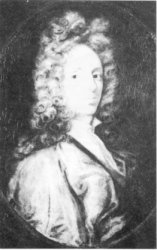
Francis Bindon was a popular architect and painter in 18th century Ireland. Bindon was highly regarded by his contemporaries and was commissioned to design buildings and paint portraits for some of Ireland's most prominent figures. Today, relatively little is known about the man, despite the number of paintings and buildings he has left as his legacy.

Drumcliff, or Drumcliffe, Dromcliffe is a civil parish in County Clare, Ireland. It includes the village of Inch and part of the town of Ennis.

Ballyhannon Castle is a medieval Irish castle dating back to the 15th century, located near the village of Quin in County Clare, on the west coast of Ireland. It is fully intact and in the Irish Governmental records it is registered as a National Monument and "Listed/Protected" structure, intended to protect its historic, architectural and aesthetic significance.

Clareabbey is a civil parish in County Clare, Ireland, named after the former Augustinian monastery of Clare Abbey. The main settlement in the town of Clarecastle.

Killone is a civil parish of County Clare, Ireland, to the southwest of Ennis. It is known for the ruins of Killone Abbey on the grounds of Newhall House and Estate.
Florence Vere O'Brien was a British diarist, philanthropist, and craftswoman. She set up The Limerick Lace School and Clare Embroidery.
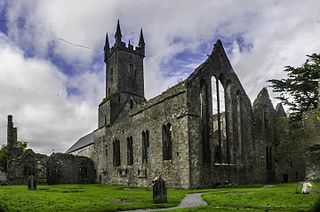
Ennis Friary was a Franciscan friary in the town of Ennis, County Clare, Ireland. It was established in the middle of the 13th century by the ruling O'Brien dynasty who supported it for most of its existence. Following the suppression of the monasteries in the 16th century, the friary continued to function for a while despite the loss of its lands. In the early 17th century, the buildings were handed over to the Church of Ireland as a place of worship. It was used as such until the late 19th century. After the construction of a new Church of Ireland building, the friary fell into ruin. Managed by the Office of Public Works since the late 19th century, it was formally returned to the Franciscan Order in 1969.
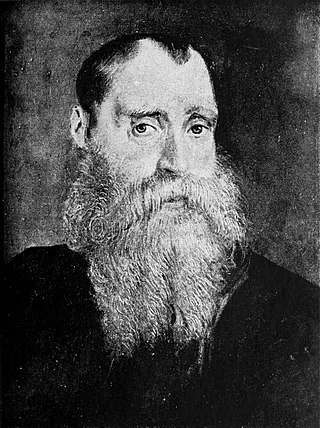
Donough O'Brien was the third son of Murrough O'Brien and the ancestor of the Leameneagh branch of that family.

Sir Donough O'Brien (1595-1634) was an Irish nobleman of the O'Brien family of Leameneagh.
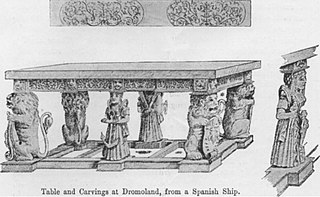
Conor O'Brien of Leameneagh was an Irish nobleman and land-owner in County Clare.





